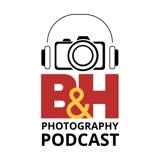
B&H Photography Podcast
B&H Photo & Video
Podcast
Episodes
Listen, download, subscribe
B&H Podcast: Chat with Inventor of the CMOS Chip, Professor Eric Fossum
How did a space-age invention become ubiquitous in today’s digital imaging landscape? Learn all about it here in our latest podcast, featuring pioneers of photography and digital imaging. In 1993, noted physicist and engineer Eric Fossum led the invention of the CMOS active-pixel image sensor as part of his work for NASA’s Jet Propulsion Laboratory (JPL). Then, as part of JPL’s mandate to seek commercial and consumer applications for emerging technologies, he was active in the transfer of the CMOS sensor’s “camera-on-a-chip” technology to industry. In our informative conversation with Professor Fossum, he makes distinctions between solid state CCDs and his more efficient CMOS sensor that would come to dominate the marketplace. To transform high-level science into layman’s terms, he uses the analogy of a bucket brigade collecting rain on a football field. In a similar down-to-earth fashion, we touch on metaphysical issues like wave particle duality, and how this is demonstrated every time light enters a camera and you take a picture with your phone. Join us to marvel at the wonders of science amid fun food references—from the way deep space radiation degrades CCD chips so they start to act like Swiss cheese, to the synergies between high-level scientific measurements and delicatessen lunch meats, both marks of a creative scientist and visionary educator. Guest: Eric Fossum Above photograph © John Sherman Photography, https://jshermanphoto.com/ Episode Timeline: 2:31: Eric Fossum’s beginnings in hands-on science explorations, computer programming, and his love for launching model rockets, plus the role photography has played in his life. 9:26: Fossum’s early research in CCD sensor technologies, his interest in trying to marry cameras to artificial intelligence, and his invitation to join NASA’s Jet Propulsion Laboratory in 1990. 14:00: The differences between CCD and CMOS sensors, and a description of how they work using the analogy of a bucket brigade to collect rain on a football field. 23:35: A history of active pixel sensor devices, an explanation about two kinds of image noise, the metaphysics of photons, plus how the wave particle duality from quantum mechanics is demonstrated every time you take a picture with your phone. 33:10: Fossum’s role in the transfer of CMOS sensor technology to US industry, co-founding his company Photobit, and negotiations for licensing the technology with CalTech. 43:23: Episode Break 44:36: The sale of Photobit to Micron, Fossum’s move to New Hampshire, consulting work on 3-D imaging sensors for Samsung TVs, and the beginnings of his teaching career at Dartmouth. 50:00: A book chapter on the future of image sensors, and the evolution of this idea to a university project, which led to Fossum co-founding the start-up company, Gigajot, with his PhD students. 52:30: Explaining the difference between the operation of CMOS and Quanta image sensors. 54:03: The resulting applications of CMOS image sensor technology, and the positive use of CMOS image sensors for social justice purposes. 57:22: Fossum’s thoughts about STEM education, and connections between academia and applications in the wider world. 1:01:32: Parting thoughts about AI and the ability to authenticate images at the source, plus Fossum’s newest award: The Trinity College President’s Medal for Science & Innovation. Guest Bio: Eric Fossum, a Queen Elizabeth Prize Laureate and recipient of a 2021 Emmy Award, is one of the world's experts in solid-state image sensors. He developed the CMOS active pixel image sensor while working at the NASA Jet Propulsion Laboratory. Today, this “camera-on-a-chip” technology is used in almost all cell-phone cameras, webcams, many digital-still cameras and in medical imaging, among other applications. A serial entrepreneur, with a career that has spanned aca
B&H Photography Podcast RSS Feed










